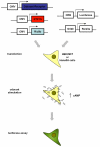Evaluating cell-surface expression and measuring activation of mammalian odorant receptors in heterologous cells
- PMID: 18772867
- PMCID: PMC2664838
- DOI: 10.1038/nprot.2008.120
Evaluating cell-surface expression and measuring activation of mammalian odorant receptors in heterologous cells
Abstract
A fundamental question in olfaction is which odorant receptors (ORs) are activated by a given odorant. A major roadblock to investigating odorant-OR relationships in mammals has been the inability to express ORs in heterologous cells suitable for screening active ligands for ORs. The discovery of the receptor-transporting protein family has facilitated the effective cell-surface expression of ORs in heterologous cells. The establishment of a robust heterologous expression system for mammalian ORs facilitates the high-throughput 'deorphanization' of these receptors by matching them to their cognate ligands. This protocol details the method used for evaluating the cell-surface expression and measuring the functional activation of ORs of transiently expressed mammalian ORs in HEK293T cells. The stages of OR cell-surface expression include cell culture preparation, transfer of cells, transfection, immunocytochemistry or flow cytometry, odorant stimulation and luciferase assay. This protocol can be completed in a period of 3 d from the transfer of cells to cell-surface expression detection and/or measurement of functional activation.
Figures






References
Publication types
MeSH terms
Substances
Grants and funding
LinkOut - more resources
Full Text Sources
Other Literature Sources
Research Materials

